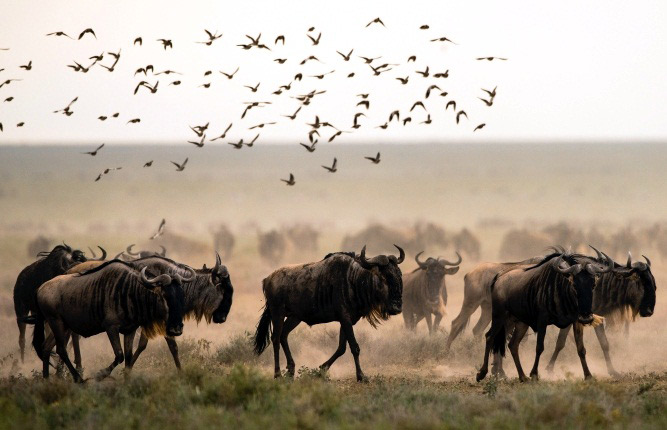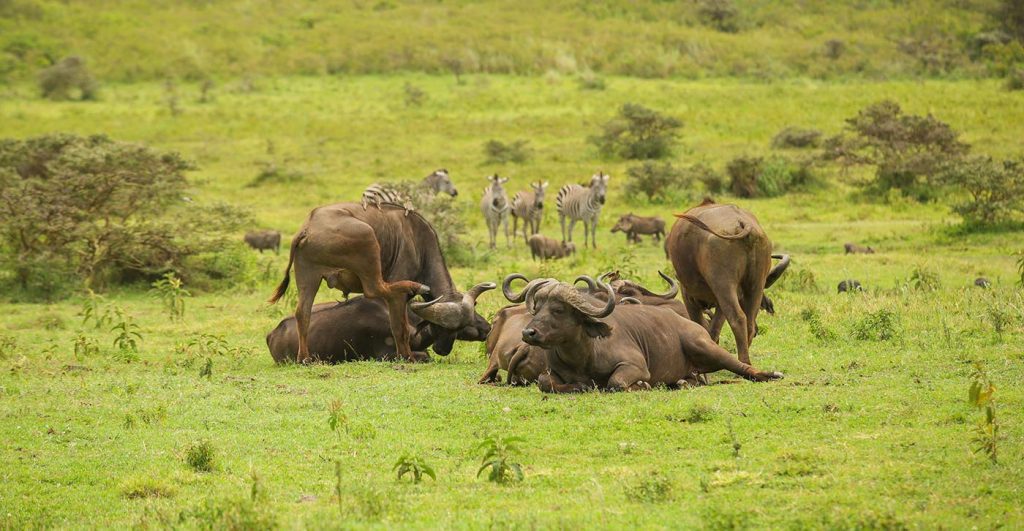Tanzania
All year round
14 square miles
88
44mm
Arusha National Park, located in northern Tanzania, is a gem among East Africa’s wildlife parks. It’s a compact yet incredibly diverse park, offering a variety of ecosystems within its boundaries. From the rugged landscapes of Mount Meru, the fifth highest peak in Africa, to the lush forests that are home to a variety of wildlife, including giraffes, zebras, and monkeys, Arusha National Park is a haven for nature lovers and adventure seekers alike.
One of the park’s highlights is the Ngurdoto Crater, often dubbed the “Little Ngorongoro.” This stunning crater is a breathtaking sight, with its steep walls and lush vegetation providing a haven for a variety of wildlife, including elephants and buffaloes. The park is also famous for its diverse birdlife, making it a paradise for bird watchers. Visitors can enjoy a range of activities in the park, from game drives and walking safaris to canoeing on the Momella Lakes, offering a unique perspective of the wildlife and landscapes.
Arusha National Park is not only a haven for wildlife enthusiasts but also a place of cultural significance. The park is home to the Meru people, who have a rich history and culture that is intertwined with the park’s landscapes. Visitors have the opportunity to learn about the Meru people’s way of life, adding a cultural dimension to their safari experience. With its stunning landscapes, diverse wildlife, and rich cultural heritage, Arusha National Park offers a truly unforgettable safari experience.
The Meru people, the primary ethnic group around Arusha National Park, have a rich cultural heritage with unique customs and traditions. They are known for their traditional dances, such as the “ngoma” dance, performed during celebrations and important ceremonies. Additionally, the Meru have a strong belief in traditional medicine, often using herbs and plants for healing purposes. Their craftsmanship is renowned, particularly in woodcarving and basketry, with beautifully crafted wooden items and intricately woven baskets showcasing traditional designs and patterns passed down through generations.
Hospitality is a key aspect of Meru culture, with visitors warmly welcomed and offered traditional food and drink. The Meru take pride in their culture and are eager to share it, making a visit to Arusha National Park not just a wildlife experience but also a cultural immersion.

Arusha National Park offers a diverse range of wildlife encounters, making it a must-visit destination for nature enthusiasts. The park is home to a variety of iconic African wildlife, including giraffes, zebras, buffaloes, and monkeys. Visitors can embark on thrilling game drives through the park’s varied landscapes, from the lush forests to the open savannah, providing ample opportunities to spot these magnificent creatures in their natural habitat.
One of the highlights of wildlife encounters in Arusha National Park is the chance to see the rare black and white colobus monkeys, which are indigenous to the area. These striking monkeys can often be seen leaping through the trees, providing a captivating sight for visitors. The park is also a haven for bird watchers, with over 400 species of birds recorded within its boundaries. Bird enthusiasts can enjoy spotting a variety of colorful birds, including flamingos, herons, and eagles, making Arusha National Park a paradise for bird watching.
Arusha National Park is renowned for its diverse and vibrant birdlife, attracting birdwatchers from around the world. With over 400 species recorded, the park offers a rich and rewarding birding experience. One of the park’s highlights is the presence of flamingos, which can often be seen wading in the shallow waters of the Momella Lakes, creating a stunning pink-hued spectacle.
The park’s varied habitats, ranging from montane forests to open savannahs and wetlands, provide a habitat for a wide range of bird species. Bird enthusiasts can spot a variety of species, including herons, egrets, pelicans, and kingfishers, among many others. The diverse birdlife, combined with the park’s picturesque landscapes, makes Arusha National Park a paradise for birdwatching enthusiasts of all levels.
Fly to Kilimanjaro International Airport (JRO) or Arusha Airport (ARK). Transfers to the Momella Gate area typically take 45–90 minutes, depending on traffic and lodge location.
From Arusha city, drive 40–60 km to park gates via well-maintained roads; 4×4 recommended for interior tracks in rain. Permits, guides, and activity bookings are arranged through operators or at designated offices.
Exploring the wildlife and attractions of this East African gem offers a once-in-a-lifetime experience filled with breathtaking landscapes, diverse ecosystems, and unforgettable encounters with nature.
No results available
Arusha National Park, located in northern Tanzania, is a stunning destination offering a diverse range of wildlife and natural beauty. From the iconic Mount Meru to the picturesque Momella Lakes, the park boasts a variety of ecosystems that are home to a wide array of wildlife, including giraffes, zebras, buffaloes, and monkeys. Visitors can enjoy thrilling game drives, bird watching, and hiking, making it a paradise for nature enthusiasts. With its rich cultural heritage, including the presence of the Meru people, and its stunning landscapes, Arusha National Park offers a truly unforgettable safari experience.
The wet season in Arusha National Park typically occurs from November to May, with the peak of the rains usually falling between March and May. During this time, the park receives moderate to heavy rainfall, which can vary in intensity. The wet season is characterized by lush greenery and blooming flowers, creating a beautiful and vibrant landscape. However, the rains can also make some areas muddy and slippery, potentially affecting road conditions and accessibility. Despite the rain, the wet season is a great time for bird watching, as migratory birds flock to the park.
JAN
FEB
MAR
APR
MAY
JUN
JUL
AUG
SEP
OCT
NOV
DEC
°C
Min
°C
Average
°C
Max
°F
Min
°F
Average
°F
Max
in
Min
in
Average
in
Max
Altitude drives Arusha’s climate. Low lakes and grasslands can feel warm by midday, while montane forest and higher Meru slopes stay cool, breezy, and mist-kissed. Typical daytime temperatures range from about 10–26°C; nights on the mountain drop further, requiring insulating layers.
The long dry season (June–October) brings clear skies, firm tracks, and comfortable walking. November–December short rains refresh foliage and stabilize canoe levels, producing colorful birding. January–March remains green with frequent bright mornings and brief afternoon showers. The long rains (April–May) deliver heavier downpours, muddy sections, and dramatic cloudscapes, but also waterfalls at their best.
UV can be strong at altitude even on cool days, and sudden squalls roll across slopes quickly. Plan early starts for wildlife and views, carry a light shell, and keep a warm layer handy for wind-exposed viewpoints or boat trips. With smart timing, Arusha’s microclimates enhance variety rather than limiting it.
Arusha National Park is considered safe with licensed guides and adherence to ranger instructions. Walking safaris require an armed ranger; always follow spacing, keep voices low, and avoid sudden movements around buffalo, giraffe, or hippo areas. Stay on signed trails—slopes can be slick after rain, and fig roots create ankle traps.
Canoe trips provide life jackets and safety briefings; remain seated during wildlife approaches. On drives, keep windows partly up near baboons and never feed animals. For the Mount Meru trek, pace steadily, hydrate, and respect turnaround times set by guides; altitude, wind, and chill are the main challenges rather than technical climbing.
Roads may be muddy in the rains; use a reliable 4×4 and experienced driver, and avoid night driving. Secure valuables discreetly at lodges and carry only essentials on walks. Mobile coverage is decent near gates, weaker in interior valleys. With basic precautions and professional guiding, Arusha delivers low-risk, high-reward adventures.
Prepare for altitude variation, cool mornings, and intermittent rain. Malaria risk exists in the region—seek medical advice on prophylaxis and practice bite prevention with repellent, evening sleeves, socks, and bed nets at lower-elevation lodgings. Drink bottled or filtered water; avoid using tap water for drinking or brushing teeth.
Eat freshly cooked meals served hot, and choose fruit that is peeled or thoroughly washed. Pack a compact kit including blister care, analgesics, antihistamines, rehydration salts, motion tablets, and personal prescriptions. For walking safaris and the Meru trek, wear supportive boots, carry a light shell, and bring a warm layer and headlamp. Pace yourself on ascents; hydrate steadily with electrolytes, and notify guides early if you feel dizzy, chilled, or nauseous.
Sun and wind can be deceptive on cool days—use sunscreen, sunglasses, and a brimmed hat. Comprehensive travel insurance that covers medical evacuation is strongly recommended due to changing mountain weather and variable road conditions. Sensible preparation keeps trips comfortable and enjoyable.

Lorem ipsum dolor sit amet, consectetur adipiscing elit. Ut elit tellus, luctus nec ullamcorper mattis, pulvinar dapibus leo.

Lorem ipsum dolor sit amet, consectetur adipiscing elit. Ut elit tellus, luctus nec ullamcorper mattis, pulvinar dapibus leo.

Lorem ipsum dolor sit amet, consectetur adipiscing elit. Ut elit tellus, luctus nec ullamcorper mattis, pulvinar dapibus leo.
Explore a range of accommodation options designed to suit various preferences and budgets at this location. From comfortable lodges and tented camps to modern hotels, the area provides convenient access to nearby attractions and activities. Scroll through the carousel to find detailed listings of each property, including amenities and contact information, making it easy to plan your stay.
No results available
Explore Arusha National Park with these recommended tours
No results available
Yes. Short transfers from Arusha or Kilimanjaro airports make day trips easy. Combine a half-day walk or canoe with a compact game drive for excellent variety and photography.
It’s a non-technical, steep high-altitude hike. Good fitness, steady pacing, layers, and hydration are essential. Guides manage acclimatization and turnaround times to keep ascents safe and enjoyable.
Yes, when led by armed rangers. Follow instructions, keep reasonable distances from animals, and remain calm. Walking offers intimate, low-impact wildlife encounters in forest and glade habitats.
Giraffes, buffalo, waterbuck, bushbuck, colobus monkeys, blue monkeys, baboons, hippos, and abundant waterbirds are typical. Predators are present but rarely seen, making the park ideal for walking and canoeing.
Numbers fluctuate with water chemistry and rains. Sightings are common in green months and during short rains, when shallow alkaline conditions favor feeding along luminous, pastel shorelines.
Easily. Many travelers pair Arusha with Tarangire or Manyara for wildlife density, then continue to Ngorongoro and Serengeti. Arusha is a perfect opener or closer to a northern circuit itinerary.
Explore other optional accommodation to consider at
No results available
Copyright © 2025 Tanzania Tour Operators. All rights reserved.